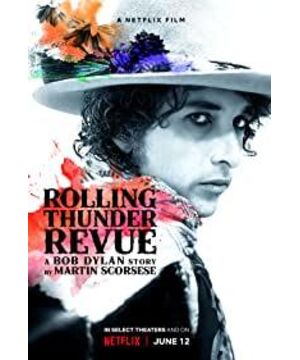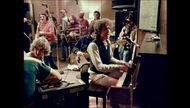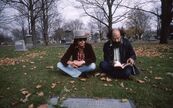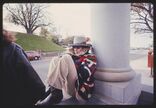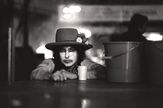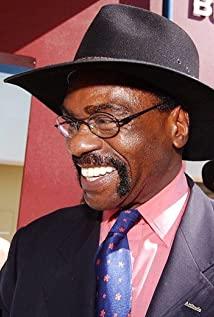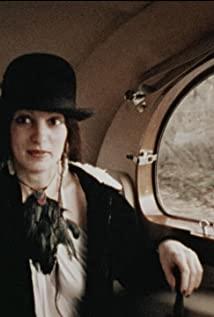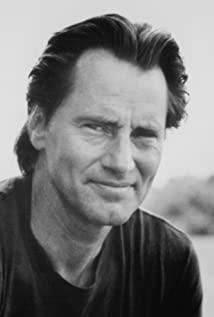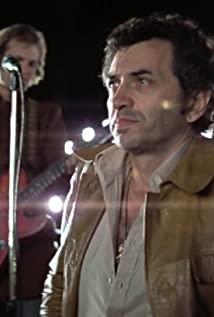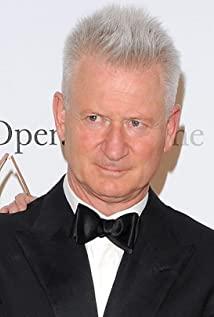"The point of life is not to find yourself, or to find anything. The point of life is to create yourself and create things." Bob Dylan, who is nearly an old man, summed up some kind of life insights in the documentary "Rolling Thunder Tour:" The beginning of "The Legend of Bob Dylan" said so. This is the second documentary filmed by Martin Scorsese for him. The film contains a large number of interviews and tour information of the parties involved, and a series of fictional characters and events. The fictitious and the real make it difficult for you to distinguish what happened. What have been past, which are the self and things created by Scorsese and Dylan together.
The German director named Stephen Van Dopp claimed to have met Dylan at a party held by Alan Ginsburg, and he told the whole process of the tour at his own expense with Rolling Thunder. Dylan commented on him that he had filmed for Madame Tussauds. He ate too much, was nosy, and suspicious. This character does not exist in reality. The young and beautiful violinist Scarlett Rivera is a real person, but she has never taken Dylan to the Kiss concert in Queens, and it is impossible to inspire the latter to wear white makeup similar to Kabuki on the tour. .
As we all know, Bob Dylan does not like to be labeled with strong political connotations, such as "anti-war", "civil rights", "protest", etc., and often rejects the heroic identity endowed by public opinion. The biggest lie of "Rolling Thunder Tour: The Legend of Bob Dylan" lies in its connection with political and social events. The Rolling Thunder Tour performed its first performance on October 30, 1975. After the incident, Gerald Rudolph Ford hurriedly took over.
Ironically, the documentary still quoted Nixon’s televised speech when he was re-elected. The ill-fated president is looking forward to the 200th anniversary of the founding of the United States in 1976, emphasizing the meaning and importance of the "American spirit" to the people of the United States. Subsequently, Nixon resigned. On April 30 of the following year, it was the "fall" of Saigon and the end of the Vietnam War.
The Rolling Thunder tour ended the last performance of the spring tour on May 25, 1976. The first historical scene in the documentary took place more than a month later. It was July 4, 1976, the National Day of the United States. . At the commemorative ceremony, the hawker who sold the 200th anniversary of the founding of the People's Republic of China said that he did not feel patriotic, but only sold what everyone liked, nothing more. On the other side, an old man dressed as Uncle Sam sang the re-composed American national anthem, "To the future America, God saves the Republic", singing impassionedly, but he did not forget to sell his printed version of the sheet music.
Scorsese unveiled the documentary with a clip from George Mélière’s "The Lost Woman in the Judia Theater". Under the full view of the public, a woman in a long skirt disappeared and reappeared under the cover of a curtain. The magic of movie editing was at the beginning. See the clues. This wonderful opening foretells that the entire "Rolling Thunder Tour: The Legend of Bob Dylan" is just a fantasy story written and blended with a camera. Even the seemingly most important confession in the film may not tell the whole truth. .
"I tried to say... the core point, I can't figure it out at all, because it's nothing, it's just something that happened 40 years ago...I don't have any memory of it... It's a long time ago. I haven't been born yet, what do you want to know?" At this point, Dylan's face showed a childlike and cunning smile.
Indeed, that was a long time ago. As mentioned in the Vietnam War, people now only remember a few key time points and long anti-war demonstrations, the 1954 Battle of Dien Bien Phu, the death of Wu Tingyan and the assassination of Kennedy in 1963, the withdrawal of troops in 1973, and 1975. The war ended. Almost in the same period, in 1963, Bob Dylan released his most famous single "Blowin' in the Wind". In 1966, he was seriously injured in a motorcycle accident and disappeared from public view. For about 8 years, it was not until 1974 that he restarted the tour. About a year and a half later, he assembled a group of talented artists, including ex-girlfriend Joan Baez and poet Alan Ginsberg, and started a 40-day Rolling Thunder tour with Plymouth as the starting point for his journey.
Netflix will choose "Rolling Thunder Tour: The Legend of Bob Dylan" to compete for the Oscar for Best Documentary Award. In recent years, the college has also accepted some documentaries with fictional elements. However, this "Rolling Thunder Tour: The Legend of Bob Dylan" "Can it be considered a documentary? The question of what proportion of fact and fiction should be maintained is left to the judges to decide. At least, all the performances, music and backstage rehearsals in the film are all real. The evaluation of "Bob likes the chaos" is true. This "power to attract everyone together" is also true.
When Scarlett Rivera played the violin, her eyes were fixed on Dylan, not only her, but anyone who witnessed Dylan's performance with his own eyes would be shocked by the shining beauty. At that time, the attempt to "rejuvenate America" was unsuccessful, and now, the release of "Rolling Thunder Tour: The Legend of Bob Dylan" in this sensitive period does not seem like a pure coincidence. Even if I believe in my heart and take pride in the "American spirit", nothing can escape the grasp and wear of time, and the "beauty" that is repeatedly emphasized in the film is no exception.
However, the Rolling Thunder tour in 1975 is still beautiful. More than 40 years later, from those carefully restored shots, we saw 34-year-old Bob Dylan standing in the center of the stage wearing a Panama crown decorated with flowers and feathers. The cap and the long scarf dragged all the way to the knee. He drew eyeliner, smeared white oil on his face, and sometimes he would wear a mask. Dylan explained the reason for wearing a mask during the tour, "Some people will tell you the truth when they wear a mask." Of course, in the present tense interview in the film, he never wore any mask.
View more about Rolling Thunder Revue reviews


